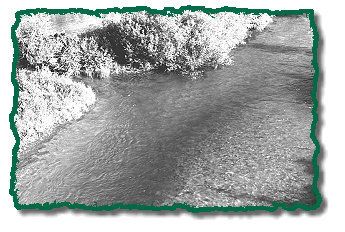Marking and approaching rising fish
Pay attention when you see a trout rise some distance up stream
by Clive Schaupmeyer
Adapted from The Essential Guide to Fly-Fishing by the author.

"You approach from a high bank and see a trout rise.
You climb down and get closer.
Exactly where did the fish rise?"
Learning to "mark" the position of fish rising on a stream and approach
them carefully will help you catch more trout.
Let's say you come around a bend and see a rise in the fading evening
light. The silvery pink glare off the smooth water is perfect for seeing
a rise ring from quite a distance. Hurriedly, you advance along the
bank. You might see the fish rise once more as you approach. You get
closer and if you're lucky you'll realize-just soon enough-that you
don't know exactly where the trout is holding, so you stop dead in your
tracks. Again it rises two casts away.
This time the gods were with you. You didn't mark the exact spot where
the trout was rising, but were lucky to stop in time. Other times you'll
get to where you think you should be and never see the trout rise again
because you got too close. I've approached risers that I thought I had
marked well only to see a fishy wave shoot away from the bank indicating
that I'd walked too near.
When a trout rises upstream, mark the spot against some landmark along
the shore or bank a clump of tall grass, an extra large rock along the
shore, a dogwood clump, whatever. From a distance you'll never get the
spot right on, but at least you'll know the general stretch. As you
approach, stop and wait for another rise. This time you'll be close
enough and can locate the trout next to a more precise landmark. You
think to yourself, or if you're like me you might even say it out loud,
"It's a rod length past the root sprig beyond the big rock." You walk
quietly up within casting distance. If it's an infrequent riser you
might smoke half a cigar before stripping out line and measuring the
cast-readying for the final rise before you give it a go.
If the fish does not rise again, and you are not sure where the fish
is, then cast ahead as you work upstream. If you are lucky it may show
again as you work up river. Or you just may catch it or another trout
anyway.
Once the fish is marked you must now approach it so you don't spook it.
The principle that governs our approach on flowing water is trout
always face upstream. Like most novices, I never knew that when I
started, and yet it still amazes me that new fly anglers don't know
this. No wonder I am not a teacher.
The most obvious significance of this is that it directs our approach
to a fish-holding pool. Normally fish are approached from downstream and
we cast upstream to them. Because trout are facing into the flow, we can
approach trout from behind without spooking them and sometimes get
amazingly close-assuming we wade carefully and quietly.
Approaching a stretch of water from downstream gets a bit tricky if you
come upon a back eddy. Back eddies are favorite holding spots for trout
because the water tends to be slower and they have close access to food
drifting by in the main stream. Emerged insects often get caught up in
back eddies, and it is common to see trout sipping bugs through the
collected foam. But half of the water in a back eddy is going against
the flow direction of the main stream and fish there will be facing
downstream toward you. As you approach a back eddy you might come into
view of fish that are facing toward you-downstream to the main flow. Be
careful.
Depending on where you fish, rising trout are normally approached from
downstream-and you cast upstream. But there are times and places where
this is not possible. Casting downstream to trout may be required
because of bank obstructions that prevent an upstream cast. And then
there are rivers where the poor trout are fished so hard they have
become incredibly leader shy and anglers must cast to rising fish from
upstream.
Needless to say, if you have to cast downstream to a rising trout you
must be aware that it is now looking in your direction. And you have to
be especially careful as you approach. It might be spooked by any number
of things flashes of sun reflecting off your waving rod; or perhaps it
can see your waders in the gin-clear water. Maybe you should have
changed your light tan shirt before heading out. Be careful.
This week's closing thought is courtesy of Doug Larson Instead of
giving a politician the keys to the city, it might be better to change
the locks.
Our closing thought is attributed to
Doug Larson
" Instead of giving a politician the keys to the city
it might be better to change the locks "
Bio on Our Man In Canada

Clive Schaupmeyer is an outdoor writer and
photographer. He is the author of The Essential Guide to
Fly-Fishing, a 288-page book for novice and intermediate fly
anglers. His photo of a boy fishing was judged the best outdoor
picture of 1996 published by a member of the Outdoor Writers
of Canada. He fly-fishes for trout in Alberta's foothill and
mountain streams and for pike near his home in Brooks,
Alberta.
For information on where to find, or how to get a copy of
Clive's book, Click here!
Our Man In Canada Archives
|



